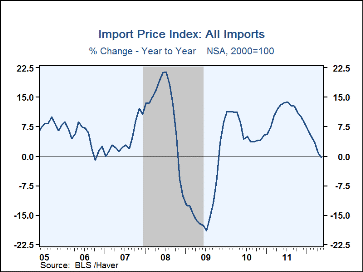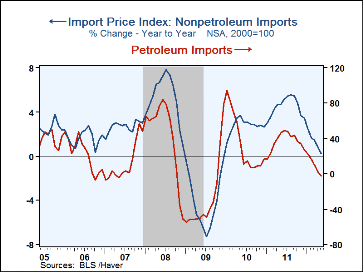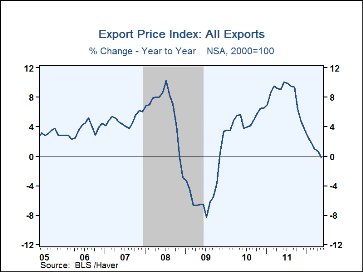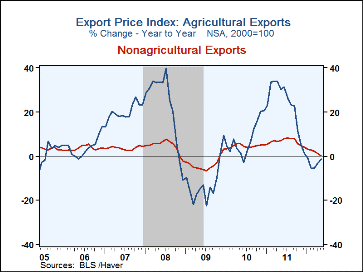 Global| Jun 12 2012
Global| Jun 12 2012U.S. and International Pricing Power Evaporates
by:Tom Moeller
|in:Economy in Brief
Summary
Less liquidity, weakness in the global economy and increased competition have taken a toll on international pricing power. U.S. import prices matched expectations and fell 1.0% during May following no-change in April, initially pegged [...]
Less liquidity, weakness in the global economy and increased competition have taken a toll on international pricing power. U.S. import prices matched expectations and fell 1.0% during May following no-change in April, initially pegged as -0.5%. The year-to-year increase in import prices fell to a minimal 0.3%, as oil prices declined. Petroleum prices fell 4.2% last month after a 0.4% April slip. Brent crude oil fell to an average $111.67 per barrel from April's $120.37 and yesterday dropped further to $98.30. Non-oil import prices slipped 0.1% (+0.3% y/y) last month following a 0.1% uptick during April. The y/y change in non-oil import prices during the last twenty years has a 59% inverse correlation with the nominal trade-weighted exchange value of the US dollar vs. major currencies.
Imported food & beverage prices fell 0.7% last month (-2.6% y/y) while prices for non-oil industrial supplies slipped 0.1% (-3.6% y/y). Prices for non-auto consumer goods ticked down 0.1% (+2.1% y/y). Furniture prices were unchanged (3.4% y/y) for a second straight month but home entertainment equipment prices fell 0.5% (-6.4% y/y). Imported auto prices slipped 0.1% (+1.4% y/y) and imported capital goods prices were unchanged (0.9% y/y). Computer & peripherals prices were unchanged (-2.0% y/y) while excluding computers, capital goods prices also were unchanged (2.2% y/y).
U.S. export prices declined 0.4% (-0.1% y/y) as nonagricultural prices fell 0.5% (+0.1% y/y) but agricultural goods prices increased another 0.7% (-1.3% y/y). Prices of industrial supplies fell 1.7% (-3.7% y/y). Capital goods prices were unchanged (1.5% y/y) and nonauto consumer goods prices rebounded 0.7% (1.8% y/y). Prices for exported autos & parts ticked up 0.1% (2.7% y/y).
The import and export price series can be found in Haver's USECON database. Detailed figures are available in the USINT database. The daily figure are in DAILY. The expectations figure is in the AS1REPNA database.
| Import/Export Prices (NSA, %) | May | Apr | Mar | May Y/Y | 2011 | 2010 | 2009 |
|---|---|---|---|---|---|---|---|
| Imports - All Commodities | -1.0 | 0.0 | 1.4 | -0.3 | 10.9 | 6.9 | -11.5 |
| Petroleum | -4.2 | -0.4 | 4.9 | -2.0 | 36.5 | 28.4 | -35.9 |
| Nonpetroleum | -0.1 | 0.1 | 0.3 | 0.3 | 4.5 | 2.8 | -4.1 |
| Exports - All Commodities | -0.4 | 0.4 | 0.8 | -0.1 | 8.1 | 4.9 | -4.6 |
| Agricultural | 0.7 | 2.0 | 2.4 | -1.3 | 22.3 | 7.9 | -12.8 |
| Nonagricultural | -0.5 | 0.2 | 0.5 | 0.1 | 6.6 | 4.6 | -3.7 |
Tom Moeller
AuthorMore in Author Profile »Prior to joining Haver Analytics in 2000, Mr. Moeller worked as the Economist at Chancellor Capital Management from 1985 to 1999. There, he developed comprehensive economic forecasts and interpreted economic data for equity and fixed income portfolio managers. Also at Chancellor, Mr. Moeller worked as an equity analyst and was responsible for researching and rating companies in the economically sensitive automobile and housing industries for investment in Chancellor’s equity portfolio. Prior to joining Chancellor, Mr. Moeller was an Economist at Citibank from 1979 to 1984. He also analyzed pricing behavior in the metals industry for the Council on Wage and Price Stability in Washington, D.C. In 1999, Mr. Moeller received the award for most accurate forecast from the Forecasters' Club of New York. From 1990 to 1992 he was President of the New York Association for Business Economists. Mr. Moeller earned an M.B.A. in Finance from Fordham University, where he graduated in 1987. He holds a Bachelor of Arts in Economics from George Washington University.










